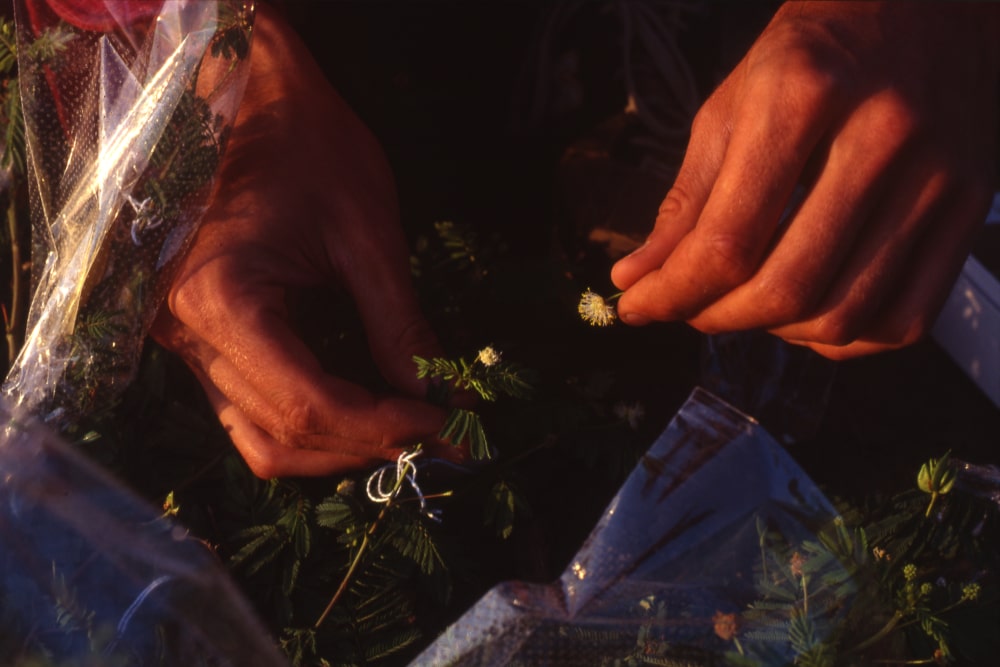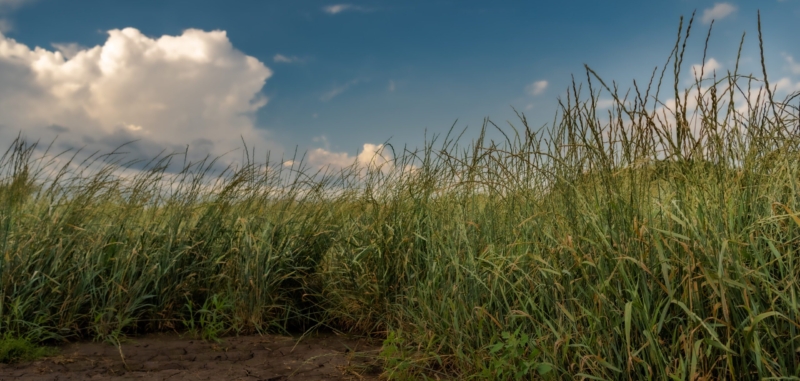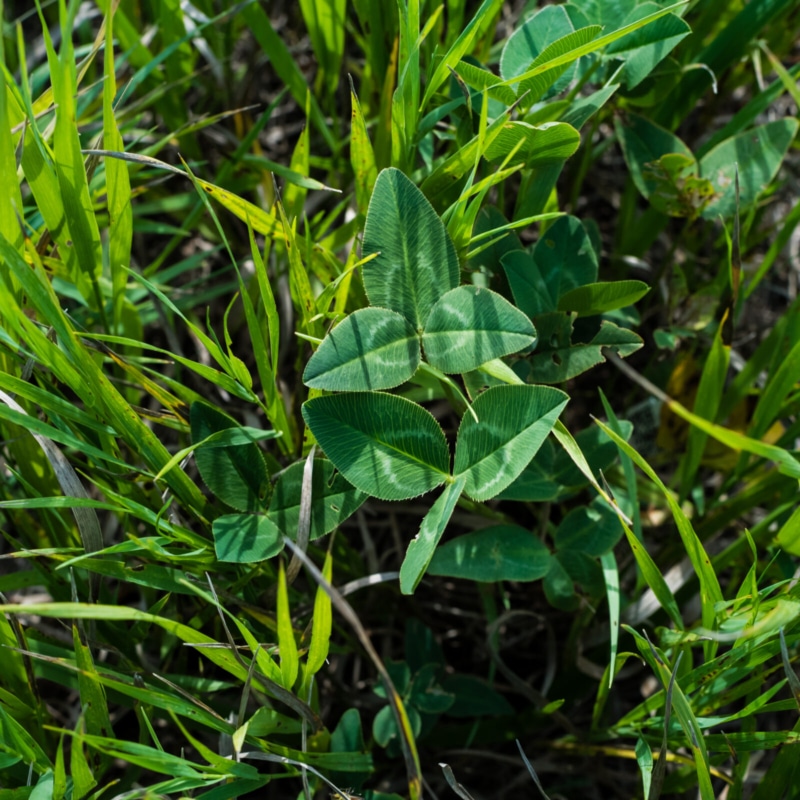Abstract
Illinois bundleflower (Desmanthus illinoensis (Michx.) MacM., Fabaceae) is a warm-season perennial legume of the North American grass-lands. It is rated by some as our most important native legume. Illinois bundleflower seeds contain 38% protein on a dry weight basis. In this review of The Land Institute’s research in developing Illinois bundleflower as a perennial seed crop, we present the species’ characteristics, nutritional value, nitrogen fixation capability, and potential for genetic improvement.
INTRODUCTION
An examination of agriculture reveals practices that use nature not as a model, but as a mine. Soil erosion, reduction of biological diversity, groundwater contamination, salinization, and dependence on fossil fuels are some results of this extractive approach. The Land Institute is a research and education organization devoted to a sustainable agriculture, that uses nature as its model. To solve the problems in agriculture, we recognize the problem of agriculture: its inherent disruptiveness. To lessen the negative effects of agriculture, we try to mimic the patterns and processes of the prairie ecosystem native to central Kansas. Each year, Land Institute research staff and interns study the prairie and conduct experiments in plant breeding with the aim of developing an agriculture that is a mixture, or polyculture, of seed-producing perennials.
This paper reviews The Land Institute’s research in developing Illinois bundleflower, Desmanthus illinoensis (Michx.) MacM., as a perennial seed crop, examining the species’ nutritional value, nitrogen fixation capability, and potential for genetic improvement. Illinois bundleflower has been called our most important native legume (Great Plains Flora Association 1986), yet there are no published reports of genetic variability within this species. We have been studying Illinois bundleflower at The Land Institute since 1979. Although it has not historically been a human food, preliminary data on nutritional value, seed yield, genetic variability, and nitrogen fixation suggest that it has promise as a perennial grain legume.
DISCUSSION
Characteristics
Illinois bundleflower is a self-fertile, perennial legume of the North American grasslands. It is found north to Minnesota, west to Colorado, and south from Texas to Florida. Native stands occur in prairies, rocky open ground, wooded slopes, stream banks, road-sides, and railroad rights-of-way (Latting 1961). It is readily eaten by livestock and has been included in range revegetation programs (Great Plains Flora Association 1986).
Unlike many prairie perennials, Illinois bundleflower sets seed its first year of growth. Seeded in May, it flowers by mid-July and matures by early September. Germination is greatly enhanced by seed scarification.
Although Illinois bundleflower has relatively high yields for a perennial, mature seed pods readily open and drop their seeds, or shatter. In 1988, The Land Institute’s plant breeder, Peter Kulakow, noticed three naturally-occurring crosses between a normal shattering collection and a non-shattering collection from Knoxville, Tennessee. The hybrids showed intermediate shattering characteristics, increased vigor, and different bundle shapes (Epp 1989). Much of our Illinois bundleflower breeding work now centers around these non-shattering hybrids.
In our research to develop a “domesticated prairie” we are seeking answers to some basic biological questions. Because a large part of a perennial plant’s energy goes into its roots, whereas in an annual most energy goes to seed production, are perennialism and high seed yield mutually exclusive (Jackson 1980)? Long-term studies at The Land Institute have shown Illinois bundleflower yields to be highest the first year of growth, and to subsequently decline. To date, however, these studies are of no-input monocultures. We are conducting similar long-term-yield studies in bicultures, growing Illinois bundleflower with a warm-season, perennial bunchgrass, eastern gamagrass (Tripsacum dactyloides (L.) L.), to study overyielding (Foreman 1989).
Nutritional Value
Because we are interested in Illinois bundleflower as a food crop, we began our investigations by sending plant clippings and seed to the U.S. Department of Agriculture Poisonous Plants Research Laboratory in Logan, Utah, to test for oxalates, cyanides, nitrates, and alkaloids. No toxic levels were found (Bruns 1985).
The seed of Illinois bundleflower is high is protein: 38% on a dry weight basis (Table 1). For comparison, soybeans are 40% protein. To test for protein digestibility, we sent cooked and uncooked seed to the University of Nebraska’s Food Protein Research Group. Protein from uncooked seed was 69% digestible; protein from seed boiled for 60 minutes was 83% digestible. (Kulakow et al. 1990). An estimate of the degree to which protein is utilized in the human body is called the computed Protein Efficiency Ratio (c-PER); Illinois bundleflower’s c-PER is close to that of cooked oats, at 1.8 (Table 2). Its seed is high in sulfur-containing amino acids, which is unusual in vegetable proteins (Bruns 1985)
Nitrogen Fixation
A second question we are exploring is whether a perennial poly-culture can maintain itself through nitrogen fixation and solar energy, as the prairie ecosystem does, and thus reduce the need for fertilizer. The percentage of nitrogen derived from symbiosis in a perennial legume such as Illinois bundleflower is likely to be greater than that of annual grain legumes, as the root nodules are perennial and fixation may begin earlier in the season (Salisbury and Ross 1985). It has been shown that nitrogen transfer occurs in mixed swards (Brophy 1987); thus, we hope to use Illinois bundle-flower as both a seed-bearing and a soil-building component of an agriculture that mimics the prairie.
In 1988, we tested the nitrogen fixation of 37 Illinois bundle-flower collections from different geographic locations. We grew seedlings inoculated with rhizobia in a perlite-vermiculite mix in our greenhouse and fertilized with a nil-nitrogen micronutrient solution every thirty days. At seventy days, the seedlings were assayed for acetylene reduction. Roots or whole plants were sealed in containers and exposed to acetylene. After one hour, a gas sample was withdrawn and injected into a gas chromatograph to measure ethylene production. We found that nitrogen fixation rates of Illinois bundleflower are comparable to those of soybeans and alfalfa. Variation in fixation rates in the 37 collections tested is adequate to select for high nitrogen fixation lines in our breeding program (Benson and Vail 1988).
Breeding Program
In 1978, we planted Illinois bundleflower in our herbary, as part of a living inventory of 300 perennial species. In 1982, we chose to study Illinois bundleflower in greater detail because of its vigor and high seed yield. In subsequent years, we conducted germination, pollination, planting density, and yield trials. In 1987, we expanded our germ-plasm studies and, in 1988, established a large Illinois bundleflower germ-plasm evaluation plot to study variation in vigor, yield, plant morphology, and shatter resistance. Plants were grown from seeds collected from 82 counties in ten states. Seeds were scarified, inoculated with rhizobia (obtained from the Nitragin Company, Milwaukee, Wisconsin), and planted in the greenhouse in March. Seedlings were transplanted to the field in May and June (Benson and Vail 1988). Yields in this study ranged from 615 to 1700 kg/ha with a mean yield of 1200 kg/ha. This is comparable to yields of soybeans in this region (Benson and Vail 1988). From this study, we have chosen twenty high-yielding collections to advance in our work with Illinois bundleflower. We are also evaluating new germ plasm collections.
We are continuing to observe the non-shattering hybrids found in 1988, and recent plantings of seeds from these hybrids have shown great variation in growth habit, seed shattering, bundle shape, stem color, and seed size. The variation in seed size seems to indicate that the non-shattering trait may be useful in breeding for both shatter-resistance and larger seeds.
CONCLUSIONS
Illinois bundleflower plays an important role in The Land Institute’s research in sustainable agriculture that uses nature-the prairie-as its model. Although specific end uses for this species still need to be identified, preliminary agronomic and nutritional analyses are encouraging. First year yields for Illinois bundleflower, a perennial, are comparable to those of soybeans in this region. The answer to our first question, are perennialism and high seed yield mutually exclusive, may be no. Illinois bundleflower also fixes appreciable amounts of nitrogen. We hope to use Illinois bundleflower as a seed-bearing fertilizer, grown in a polyculture of perennial grain crops.
LITERATURE CITED
Benson, L., and J. Vail. 1988. Illinois bundleflower germ plasm development. The Land Institute Research Report 5:12-13.
Brophy,L.S., G.H. Heichel, and M.P. Russelle. 1987. Nitrogen transfer from forage legumes to grasses in a systematic planting design. Crop Science 27:753-758.
Bruns, M. 1985. Illinois bundleflower: a perennial feed or food crop? The Land Report 25:6-9
Epp, R. 1989. Evaluation of Illinois bundleflower germplasm. The Land Institute Research Report 6:5-8.
Foreman, C. 1989. Evaluation of Illinois bundleflower and eastern gamagrass germplasm in monocultures and bicultures. The Land Institute Research Report 6:20-24
Great Plains Flora Association. 1986. Flora of the Great Plains. University of Kansas Press, Lawrence.
Jackson, W. 1980. New roots for agriculture. Friends of the Earth, San Francisco. (Pages 114-136.)
Kulakow, P., L.L. Benson, and J.G. Vail. 1990. Prospects for domesticating Illinois bundleflower. Pages 168-171. In J. Janick and J.E. Simon (eds.). Advances in New Crops. Timber Press, Portland, Oregon.
Latting, J. 1961. The biology of Desmanthus illinoensis. Ecology 42:487-493.
Salisbury, F.B. and C.W. Ross. 1985. Plant Physiology, 3rd edition. Wadsworth Publishing Company, Belmont. (Pages 251-267.)
Presented Aug. 5, 1990
Published 1992














